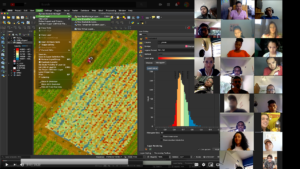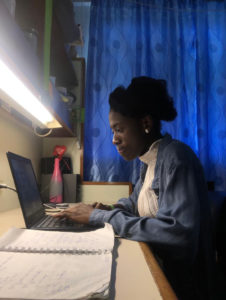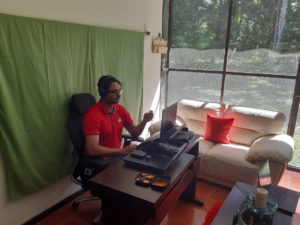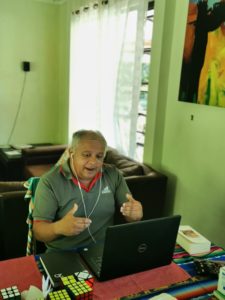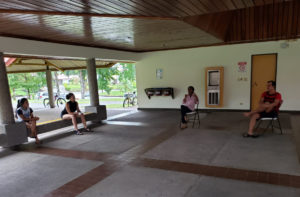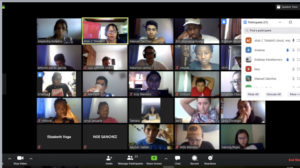Technology & empathic resilience: How EARTH adapts to COVID-19
When the COVID-19 crisis hit Costa Rica, Dasha Montcalm (’20, Costa Rica) sensed her anxiety swelling. She had never felt that way before. She found herself walking around a campus with significantly fewer people than usual, her heart racing as she became aware of the changes. “Our usual world became a world full of challenges that need to be seen with sensitivity and very human eyes,” says Dasha, who now feels at peace. She and her peers have channeled their many emotions into focused energy, seeking solutions to minimize the crisis’s isolating effects on the campus community.
EARTH University has long been recognized for its unique academic model, based on learning-by-doing. These days, resilience has been a challenge, but it has also become an opportunity for growth and an opportunity to lead. Before the Costa Rican government announced an official protocol to face the pandemic, the University had begun to envision possible scenarios, each outlining different ways to effectively and ethically take action, and thus safeguard the entire community.
The creation of a COVID-19 taskforce was a key factor in the transition, enabling University officials to swiftly act, adhere to the pandemic protocol as decreed by the national Ministry of Health, restructure the annual calendar, and analyze each area of the University, including the academic, the operational, and the financial. “We were clear that EARTH was not going to stop,” says Yanine Chan, Dean and Vice president of Academic Affairs at EARTH. “Our primary objective is to take care of our students, and we knew that most of them were going to stay here.” In fact, 75 percent of the student population decided to remain on campus.
The whole community has been resilient in the face of these changes, ensuring that EARTH’s time-tested model is adapted to meet global conditions. The faculty have collaborated to virtualize their courses. Students have organized support groups through face-to-face workshops (of up to six people) and through virtual platforms. Staff from all areas have worked hard to support the University and its mission: to prepare young leaders who will build a more sustainable and just world. Now, stronger than ever, EARTH reaffirms all the reasons that had motivated its opening 30 years ago.
From the physical field to the virtual classroom
One of the most pressing challenges amid so many changes has been modifying classes to be internet-based in a short time, by using different online platforms and technological tools. The fact that EARTH’s education model is unique compared to that of the common university has incentivized creativity, flexibility, and innovation in adjusting courses for social distancing.
For example, the classes of Víctor Morales, professor of tropical forestry, are usually 70 percent field practice and 30 percent theoretical study in the classroom. Morales has implemented digital tools so that, even though students cannot head outside to work on the farms, they still have interactive and dynamic classes. He sought ways to virtualize analog processes through tutorials that he records and edits; through digital learning tools such as Moodle, Nearpod, and Menti.com; and through virtual discussion spaces.
“I’ve created video tutorials that students can access permanently, so they can watch them again and take notes if necessary. I’ve put all the digital content on YouTube. In the next academic trimester, I’m going to make short, accessible tutorials on TikTok – the social network students already use to make and watch videos. I think the class will be more fun. I want to take advantage of the resources they use every day, use them smartly, and make class more playful and horizontal,” says Morales. “Emotion is one of the greatest learning engines. All these tools have been fundamental.”
According to Carlos Rodríguez, academic adviser at EARTH, the use of these tools is one of the great lessons that the crisis is leaving behind. The faculty is testing and applying new teaching methodologies that complement the University’s traditional academic model. He says that a constant, collaborative camaraderie has been established among faculty, in which they exchange techniques and digital tools to make each other’s classes even better. Each faculty member adopts the methods most conducive to learning in their particular course.
The exploration of the digital world and technology has also opened up space for new scenarios: “virtualization is enabling a faculty member here to ask a colleague in Europe, Asia, or Africa to visit his or her class,” says Dean Chan. “There is a constant and rich exchange of knowledge. We’ve invited our alumni and experts to join in. For example, in the first week of the next academic trimester, Dr. Franklin Chang-Díaz (Costa Rican astronaut and physicist) is going to be part of a virtual forum with all 420 students and EARTH’s President. That was never done before. The possibilities for high-level speakers are infinite.”
Students helping students
Dasha says she could have returned home to the province of Heredia, Costa Rica. She decided, however, to continue living on EARTH’s campus in Guácimo because she saw the crisis as an opportunity to deepen the impact of her role as a student leader and caring classmate who desires first and foremost to help others. She says that all the students still on campus have different situations. Some of them are unable to communicate with their families for weeks because they reside in rural areas in other countries where access to internet is limited. This was causing a feeling of anxious uncertainty to pervade the community.
In response, the students have been organizing themselves to hold sessions of yoga, meditation, musical expression, and dialogue. The Student Affairs unit has been part of the process, helping to ensure all the workshops can take place while following the strict social-distancing guidelines. The Student Council has created spaces for conversation, which facilitates stronger connections between the students, regardless of their academic year or home country.
Dasha now feels more at ease. She is proud of the spaces they have created for dialogue and listening. She’s thankful that the crisis is being handled with such humanity and the students are receiving the necessary support to take care of each other’s mental health. “We want to normalize feelings,” Dasha says. “We understand that because of all the drastic and sudden changes, we sometimes feel stressed, anxious, tense, and scared – but we should not panic. We strive to understand that these feelings are part of the process and that our responsibility as leaders is to channel them.”
EARTH is certain that – whenever this crisis finally passes – all that will have been gained will be greater than whatever has been lost; that the exploration and newfound use of digital tools will have enabled an expansion of knowledge, both academic and interpersonal. The connections between the community are growing stronger than ever. The University continues to advance because, even at a distance, we all remain united and moving our mission forward with empathic resilience.

